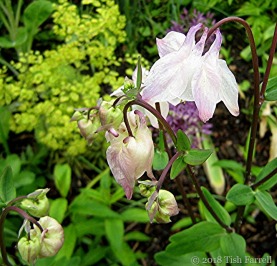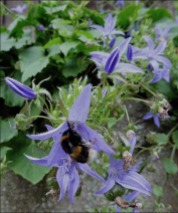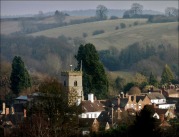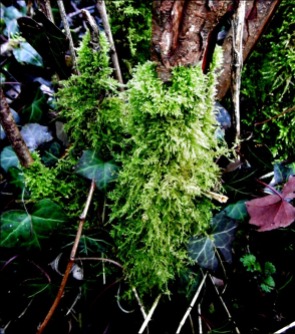Spring has been all of a gallop this month, as if plant life is set on making up for lost time. Within the space of two weeks the rapeseed field behind the house went from muddy, over-wintered, pigeon-scoffed plants, scarcely a foot high – to a billowing yellow sea taller than me. (Oh, the unbridled power of agri-chemicals!) It has anyway been great fun walking down the tractor trails within the crop, completely surrounded by sweet-smelling eye-high yellowness, and coming home covered in petals.

Now though, the flowers have almost gone, helped on their way by the last two days of storm and cloud burst. This morning it is foggy over the Edge. Fog in May? And I can’t see the wood at the top of the field.
In the garden there have been changes too. Behind the house, on our top level, the last scrap of lawn had been dug up, and the shed of He Who Builds Sheds And Binds Books now has a smart gravel forecourt, complete with red geranium in pot, which really isn’t what a chap wants outside his lathe and screw-collection domain, but I think looks jolly. Btw: the shed doesn’t actually have a chimney. Not too keen on the plastic water butt, but it’s there for now – water-gathering over aesthetics.

Our neighbour Roger also gave us some wooden sleeper pieces, left over from his own garden make-over, and these have now been used to contain the main herbaceous border beside said shed. The border has been blooming with aquilegias which are now giving way to alliums, foxgloves, euphorbia and oriental poppies. I have also put in the plants bought at the Arley Plant Collector’s Fair last week (previous post), and am looking forward to china blue scabious and sweet scented phlox in a few weeks’ time. The bed is now officially FULL.
The narrow border on the left hand side of the gravel, and above our kitchen door, has also been given a containing wooden edge by re-purposing timber thrown on the bonfire heap at the allotment and duly carried home across the field. Yesterday I noticed that the small Coxes apple tree that is growing there is now busy making apples. So soon. It was all blossom only last week.
Now shed-building man is wondering what he can do to the old privies to stop them being head-banging, dysfunctional garden sheds, this while still retaining rustic quirkiness. At the moment a very fine, self-planted foxglove is growing beside them so operations are presently on hold.
Out at the front of the house, half of our boundary is open to the kerb-side. I have replanted the border with assorted verbascum, alliums, centaurea, hesperis, foxgloves, hellenium hoopesii (very yellow), Whistling Jack (a magenta, Byzantine gladiolus) and a few other things, including a small weeping crab apple called Red Jade. This border is my cultivated response to motorists who insist on breaking the 30mph speed limit (and the law) by speeding along Sheinton Street at 40mph and above.
And now here are more scenes from the Farrells’ May garden, beginning at the front. It’s all rather rampant:
And in the back garden:
This slideshow requires JavaScript.
The Changing Seasons
Please visit Su to see scenes from her recent trip round NZ’s South Island










































































